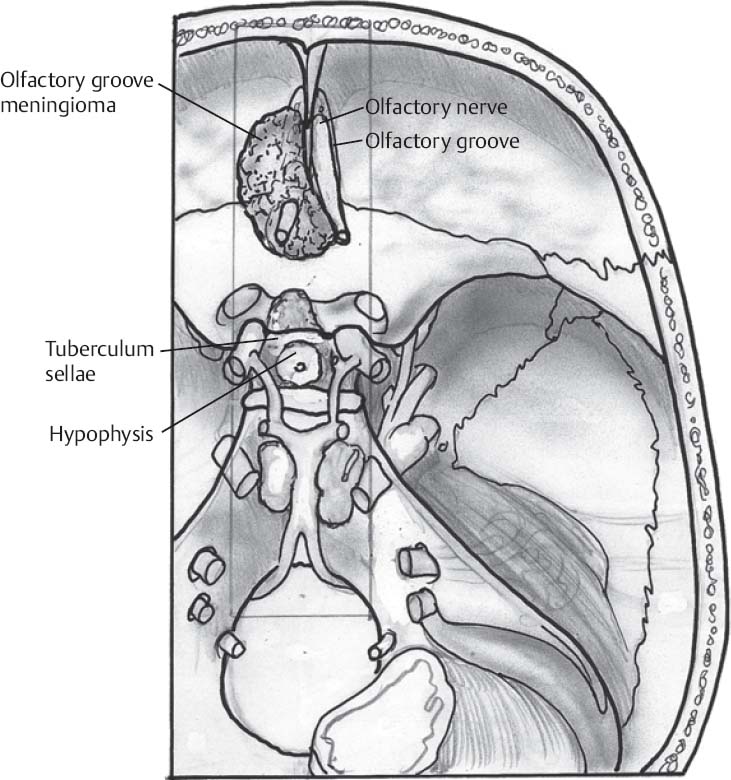♦ Preoperative
Operative Planning
- Imaging
- Gadolinium-enhanced brain magnetic resonance imaging (MRI): determine lesion origin at tuberculum sella or cribriform plate; determine extent of disease affecting optic nerve, optic chiasm, optic canal, orbit, cavernous sinus, internal carotid artery, anterior cerebral artery (ACA) branches, and extracranial sinus involvement
- Computed tomography (CT): evaluate for hyperostosis or erosion
- Location of optic nerves and chiasm are inferolateral to olfactory groove meningiomas and superolateral to tuberculum sellae tumors
- Consider preoperative angiography and possible embolization
- Acquire preoperative gadolinium-enhanced MRI scan for intraoperative image guidance
- Gadolinium-enhanced brain magnetic resonance imaging (MRI): determine lesion origin at tuberculum sella or cribriform plate; determine extent of disease affecting optic nerve, optic chiasm, optic canal, orbit, cavernous sinus, internal carotid artery, anterior cerebral artery (ACA) branches, and extracranial sinus involvement
- Extent of resection
- Extent of resection based on Simpson grade correlates with recurrence of disease
- Postoperative radiation therapy significantly decreases recurrence and progression; sub-total resection followed by radiation therapy is advocated if complete resection carries the risk of significant morbidity
- Extent of resection based on Simpson grade correlates with recurrence of disease
- Neuro-ophthalmology
- Preoperative evaluation to document existence of visual field and cranial nerve deficits
- Endocrine evaluation to identify endocrinopathies
Routine Equipment
- Lumbar drain set-up
- Major craniotomy tray
- Microsurgery tray
- Mayfield head holder
- High-speed drill
- Operating microscope
- Fibrin glue
- Image guidance system
- Leyla bar or Greenberg system for self retaining retractors
- Tarsorrhaphy set-up
Operating Room Set-up
- Headlights
- Loupes
- Bipolar and monopolar cautery
- Image guidance equipment
Anesthetic Issues
- Antibiotics: cefazolin, 2 g intravenous (IV) at least 30 minutes prior to incision and then every 4 hours; or vancomycin, 1 g IV 30 minutes prior to incision and then every 12 hours
- Dexamethasone (10 mg IV) preoperative
- Antiepileptic medication: phenytoin, 15 mg/kg IV during surgery to achieve therapeutic level
- Mannitol: 1 g/kg IV at incision
- Precordial Doppler to monitor for air embolism (superior sagittal sinus exposed with bifrontal craniotomy)
- Potential exists for high volume of blood loss (1 liter or more)
- Arterial line and either good peripheral venous or central venous access
♦ Intraoperative
Spinal Drain
- Five to 10 mL of cerebrospinal fluid are removed periodically to facilitate brain relaxation and reduce excessive frontal lobe retraction.
Positioning
- After intubation, the patient is placed in a lateral decubitus position for lumbar drain insertion. The patient is then positioned supine. The neck is slightly extended. The head is placed on a horseshoe headrest or pinned in a Mayfield head holder if self retaining retractors or image guidance is utilized for resection of intracranial disease.
Tarsorrhaphies
- Performed bilaterally
Preparation of Operative Fields
Bifrontal Craniotomy
- Bilateral Sutar-type incision; the scalp and galea are reflected anteriorly; the pericranium is isolated as a separate flap; the pericranium is incised behind the scalp incision to maximize the size of this flap and it is reflected anteriorly. Care must be taken to ensure the pericranium remains in one piece and is well vascularized. The periorbita is reflected from the orbits. At this time the ethmoidal arteries are coagulated and divided for olfactory groove meningiomas. Temporalis muscle is reflected inferiorly and the supraorbital neurovascular bundles are reflected from their foramina or notches.
- Bifrontal craniotomy is then performed. This craniotomy should extend from one superior temporal line to the other. Dura is reflected from the floor of the anterior cranial fossa.
- Nasal, ethmoid, and orbital osteotomies are performed to remove the supraorbital bar.
- Frontal sinus exenteration is performed.
Dural Opening
- Dura is opened across the frontal poles. The superior sagittal sinus and falx are divided above the crista galli after suture ligation of the sinus.
- With tuberculum sellae lesions, the olfactory tracts are dissected using the operating microscope and preserved.
Tumor Resection (Fig. 41.1)
- Using the operating microscope, the arachnoid plane between the tumor capsule and brain is developed. Internal debulking of the tumor to minimize brain retraction is completed with ultrasonic aspiration.
- Specimens are sent to verify pathology
- Tumor debulking and resection is carried posteriorly. Usually arachnoid planes persist between tumor capsule and brain tissue. Vessels clearly outside the capsule should be preserved.
- Tumor present in the tuberculum sellae is resected after removing the dura from this region followed by drilling of the bone so as to clearly visualize the tuberculum sellae. Sphenoid mucosa may be observed and is left intact.
- Resection proceeds into the optic canal if tumor is present after the optic canal roof is drilled and the falciform ligament is transected.
- Tumor invading the cavernous sinus may be resected if the consistency of the tumor is favorable.
- Tumor extending into the ethmoid sinus is resected after appropriate osteotomies.
- Dura involved with tumor is resected or extensively coagulated.
Reconstruction
- A fat graft is placed over the sphenoid sinus mucosa if the tuberculum sellae was drilled and is secured with fibrin glue.
- Resected dura is reconstructed with bovine pericardium graft or pericranium.
- The anterior cranial base is reconstructed. The supraorbital bar is first secured. The pedicled, pericranial flap is then layered over the defect in the anterior cranial fossa and secured to dura with several sutures. A split-thickness calvarial bone graft can be fashioned to cover any bone defect in the floor of the anterior cranial fossa and is inserted between the leaves of the pericranial graft. Fibrin glue is generously applied.
< div class='tao-gold-member'> Only gold members can continue reading. Log In or Register to continue
Only gold members can continue reading. Log In or Register to continue







